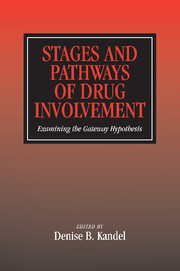Book contents
- Frontmatter
- Contents
- List of Contributors
- Foreword
- Preface
- Part I Overview
- Part II Recent Substantive Findings: What Do We Know About Stages of Drug Use, Risks, and Protective Factors?
- 2 Drug Sequences, Age of Onset, and Use Trajectories as Predictors of Drug Abuse/Dependence in Young Adulthood
- 3 Substance Use Norms and Transitions in Substance Use: Implications for the Gateway Hypothesis
- 4 Stages of Drug Involvement in the U.S. Population
- 5 Substance Use Progression and Hard Drug Use in Inner-City New York
- Part III Impact of Prevention Interventions: A Test of the Progression Hypothesis
- Part IV Methodological Issues and Approaches: Advantages and Limitations of Alternate Methods
- Part V Animal Models and Biological Processes: Implications for Drug Progression
- Part VI Conclusion
- Index
4 - Stages of Drug Involvement in the U.S. Population
Published online by Cambridge University Press: 25 July 2009
- Frontmatter
- Contents
- List of Contributors
- Foreword
- Preface
- Part I Overview
- Part II Recent Substantive Findings: What Do We Know About Stages of Drug Use, Risks, and Protective Factors?
- 2 Drug Sequences, Age of Onset, and Use Trajectories as Predictors of Drug Abuse/Dependence in Young Adulthood
- 3 Substance Use Norms and Transitions in Substance Use: Implications for the Gateway Hypothesis
- 4 Stages of Drug Involvement in the U.S. Population
- 5 Substance Use Progression and Hard Drug Use in Inner-City New York
- Part III Impact of Prevention Interventions: A Test of the Progression Hypothesis
- Part IV Methodological Issues and Approaches: Advantages and Limitations of Alternate Methods
- Part V Animal Models and Biological Processes: Implications for Drug Progression
- Part VI Conclusion
- Index
Summary
The preceding chapters have described developmental patterns of use in different populations, as well as risk and protective factors for progression to various stages of use. With the exception of the research of Golub and Johnson, the studies are based on representative longitudinal school or community samples of adolescents and young adults selected from different regions or cities in the United States. The representative samples do not extend through the entire period of risk for initiation of illicit drugs. The older sample described by Golub and Johnson in Chapter 5 is of particular interest because it consists of deviant individuals. It is not clear, however, to what extent the patterns observed in that sample are affected by factors that determine criminal behavior and apprehension by the police. In all the studies, the conceptualization of stages is characterized by two features. All illicit drugs other than marijuana are aggregated into a single class and no attempt is made to determine an order among these drugs. Furthermore, with the exception of the chapter by Labouvie and White (Chapter 2), the focus is mostly on progression from one class of drugs to another; no attention is paid to progressive involvement within a particular drug class.
We take advantage of a large national data set to explore previously unexplored substantive and methodological issues related to drug use progression.
- Type
- Chapter
- Information
- Stages and Pathways of Drug InvolvementExamining the Gateway Hypothesis, pp. 65 - 89Publisher: Cambridge University PressPrint publication year: 2002
- 39
- Cited by

